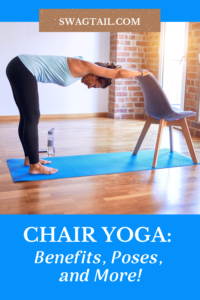 Chair yoga is one of the most accessible forms of yoga because you can do it from a seated position. It’s a great way to start if you’re a beginner, have limited mobility, an injury, or even are desk-bound for most of the day and want to boost your energy. The best part is you receive numerous benefits of the body and mind with chair yoga, and you can learn the basics to get started in this blog post.
Chair yoga is one of the most accessible forms of yoga because you can do it from a seated position. It’s a great way to start if you’re a beginner, have limited mobility, an injury, or even are desk-bound for most of the day and want to boost your energy. The best part is you receive numerous benefits of the body and mind with chair yoga, and you can learn the basics to get started in this blog post.
During my master’s program in Kinesiology, I had the opportunity to work with a variety of populations including seniors and those with multiple sclerosis (MS). This taught me to quickly adapt my knowledge of body movement in ways that fit the needs of any individual.
I was so inspired by these encounters that I wanted to teach these under-served niches. So with degree and 200-hour yoga teacher training certificate in hand, I started my yoga business. Part of my time was spent working with athletes. The other half was teaching chair yoga at various senior centers in town.
Yet, contrary to common belief, chair yoga isn’t just for the elderly. It’s a practice I use in my Flexible Golfer Program to make certain yoga postures accessible to those with limited flexibility.
Because of its many uses and benefits, I’m sharing more details about chair yoga in this article today.
Photo Credit: Kraken Images
WHAT IS CHAIR YOGA?
Hatha yoga is the umbrella of a yoga practice that uses physical postures and breathing techniques to increase your well-being. Chair yoga is one specific form of Hatha yoga. It’s a great technique for anyone new to yoga who wants to increase flexibility and strength. Chair yoga is also a wonderful way to stay active if you have limited mobility, a chronic illness, or you’ve sustained an injury.
This is because chair yoga is slower in nature than other styles of yoga. And, as the name suggests, you use a chair throughout class for support.
Many yoga postures are done from a stable position while seated. The chair also becomes a wonderful prop to help with balance in standing postures. You can even use the chair as a prop from a floor-based position to open up the body in new ways as well.
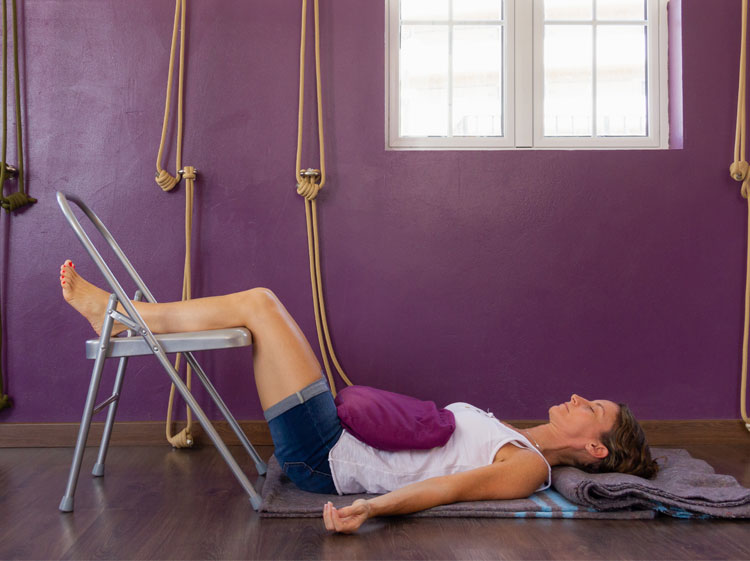
Photo Credit: Josu Ozkaritz
BENEFITS OF CHAIR YOGA
Just like other physical yoga lineages, like Ashtanga or Iyengar yoga, there are numerous benefits of practicing chair yoga. Some of these perks include:
 Improved flexibility, balance, and strength
Improved flexibility, balance, and strength- Greater ability to manage life tasks (like gardening, playing with kids and grand kids, competing in your sport at a higher level)
- Enhanced awareness and focus
- Greater muscle tone
- Increased confidence
- Reduced levels of stress
- Less physical pain
- Slowed degeneration and aging
Because of the deliberate way in which yoga postures are sequenced together in this practice, chair yoga can be used to form a strong knowledge base from which to progress. And it can be used in creative ways, like on the golf course, to improve athletic performance.
Photo Credit: Ember and Earth Photography
CHAIR YOGA MINDSET
Your mindset affects every aspect of your life. The thoughts you have about a person or subject can enhance the experience. Or, they have the ability to make it miserable. The same is true when you decide to practice chair yoga. So in order to get the most out of your time on the mat (and on your chair), adopt this attitude before you start.
Your health is determined by the Flexibility of your Spine
The spine is responsible for three main things:
- Protecting the spinal cord, nerve roots and several of the body’s internal organs.
- Providing support so you can remain balanced and upright, and
- Enabling flexible motion
That’s why all styles of yoga, including chair yoga, move the spine in all directions. You fold forward, stretch laterally, twist, backbend, and invert. Thus, when you assume various postures in class, it’s important to remember that you’re doing all of this to enhance your spinal health. This translates to many of the other benefits you experience in the nervous system, muscular system, and other areas of the body.
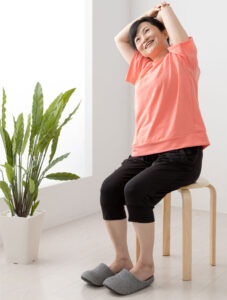 Adopt a Beginner’s Mind
Adopt a Beginner’s Mind
Traditionally, the concept of “beginner’s mind” comes from the Zen practice of meditation, and it speaks to the state of mind when you don’t try to make something happen. You don’t want to force a result or an outcome.
This is especially relevant when you start something new (like chair yoga). You want to approach it without any expectations and you want to remain curious about how the experience will unfold. This will create a more enjoyable practice. Plus, it will allow you to receive the exact benefits you need in surprising and delightful ways.
Focus on Breathing
Just like you use metrics in your yoga business to gauge your success, you need a reference point by which to check your progress when practicing chair yoga. The breath is that scale.
In most yoga classes, you breathe in and out through the nose. Not only does this warm and moisten the air with each inhale and induce the relaxation response on the exhale, you can understand your level of exertion with the rate of your breathing as well.
For example, if you’re in a lateral bend as demonstrated in the image below, you are exerting more energy in the body to lift the arms and stretch to the side. If your breathing becomes shallow and difficult, you’ve gone too far. You’re working too hard and need to back off in the pose.
The bottom line is that you can focus on your breathing in chair yoga to determine when to push deeper, when to take it easier, and when you’ve found that sweet spot where your rate of breathing supports you in the movements.
Think Progress, Not Perfection
Many people fail to overlook yoga as a beneficial training tool because the media portrays it as an activity for those who are already extremely flexible. You see the uber strong in pretzel-like positions in advertising and your social media feed. Yet, yoga is far more than what any given posture looks like.
In fact, when doing chair yoga, you’ll likely not be doing anything like what you see on a commercial. Instead, you want to focus on the progress you make with your body. You can answer questions like:
- Where are you stronger?
- Are there parts of the body that are more spacious or free of pain?
- Can you take a deeper breath in those challenging moments in yoga and in life?
When you pay attention to the steps you’re making toward your goals instead of the image of what a perfect yoga pose could be, you’ll be motivated to stick with your chair yoga practice much longer.
CONTRAINDICATIONS OF DOING CHAIR YOGA
A contraindication is a limiting factor that could prevent you from starting or being able to participate in a chair yoga practice. Or it’s a condition that indicates chair yoga could actually be harmful.
There are two types of contraindications:
- A relative contraindication means that caution should be used doing physical activity, yet participating is still acceptable when the benefits outweigh the risk. For example, if you have high blood pressure, you can still do chair yoga. Only, you should likely avoid certain postures like a forward fold where your head goes below your heart. This shift in orientation could make you lightheaded.
- An absolute contraindication means that your life could actually be threatened by doing chair yoga. A recent heart attack, regular chest pains, or an acute infection are just a few examples. Check out this list of absolute contraindications of exercise here. If you (or your clients) have any of these conditions, you want to avoid any exercise that is not prescribed by your doctor.
According to the American Family Physician Journal, “generally healthy adults without chronic health conditions do not need to consult with a physician before starting an exercise regimen.” Yet, if you’re still questioning whether a chair yoga practice is right for you, make an appointment with your health care practitioner to discuss your options.

Photo Credit: yodiyim
5 CHAIR YOGA POSES TO BOOST WELL-BEING
There are numerous yoga postures that can be done with a chair. Some are simply modified from their original shape. Others are drastically altered to still give you the same physical and mental benefits. In any case, here are five poses you can do today for greater well-being.
Before you get started:
- Refrain from eating for at least two hours before starting
- Wear comfortable clothing
- Place your chair on a sturdy surface. This could be on a yoga mat or on any other material that will keep your chair stationary while you move when seated on it.
(1) Cat / Cow
Purpose: The goal of this pose is to move the spine through flexion and extension. The cat part of the pose rounds the spine into a forward fold. The cow is a gentle backbend that opens the heart and front of the shoulders.
Notes: Start seated in the chair, with both feet firmly on the ground and your spine tall. Place your hands just above your knees. Inhale to tilt the pelvis forward, arch the low back, and lift the heart toward the chin. On the exhale, reverse the movements–round the low back, create space between the shoulderblades, and tuck the chin toward the chest.
Length: Repeat 5 times.
(2) Chandrasana (or lateral bend)
Purpose: Lateral bends are a great pose to use in a chair yoga classes because they lengthen the sides of the body, create heat and mobility in the shoulders, and prepare the spine for twists.
Notes: On an inhale, reach both arms toward the ceiling (keeping them shoulder-distance apart. Then, use the right hand to grab the left wrist and reach over to the right. This will stretch the left side body. Use your next inhale to come back to center, left hand grabs right wrist, and exhale to reach to the left. The right side will now elongate.
Length: Repeat 5 times.
(3) Uttanasana (forward fold)
Purpose: This seated version of a forward fold lengthens the entire back line of the body. It’s also a resting pose and way to turn your focus inward.
Notes: From your neutral seated position, take your hands to your knees again. Keeping your sitting bones grounded, start to fold forward until you can rest your elbows on the thighs. If you don’t have any contraindications such as high blood pressure, you can fold forward even more until your torso rests on your quadriceps.
Length: Stay for 1 minute. Make sure you use the inhale (or many cycles of breath) to come up slowly.
(4) Seated Twist
Purpose: Twists create space between each vertebrae of the spine. They also bring fresh blood flow to many organs and improve digestion. Done in this seated position, you can get all of the increased energy and range of motion benefits you would from a standing or floor-based position.
Notes: Inhale to sit tall. Exhale and take your right hand across your left knee, and your left hand behind you on the chair. Take 5 cycles of breath here. Then, inhale to return to center and repeat on the second side.
(5) Down Dog
Purpose: This down dog variation is common in many chair classes. You can adjust the level of intensity by how far back you move your hips and how far forward you fold. In any case, you will strengthen the arms, core, and hip stabilizing muscles while simultaneously lengthening the sides of the body and hamstrings.
Notes: Stand behind your chair with your hands on the back of it. Keep your feet hip distance apart as you walk them further away from the chair. This will cause your torso to begin to fold so you can stay connected to the chair. Keep your bellybutton drawing to the spine so the core is engaged. Then once you find a challenging point where you can still breathe evenly, stay for 5-10 cycles of breath. To come out, slowly walk your feet back toward the chair.
PUTTING IT TOGETHER
Chair yoga is a fantastic practice to increase flexibility, strength, and mental focus. While it’s often thought of as a way for older adults to access yoga, chair yoga actually serves a wide audience. This includes athletes, individuals who have sustained an injury, or even people who are desk-bound during the day and want an energetic boost.
Take Action Now:
- Get on your chair and try these five poses today.
- Take a chair yoga class with me on my YouTube Channel
- Check out our Chair Yoga FAQs to learn more about teaching chair yoga


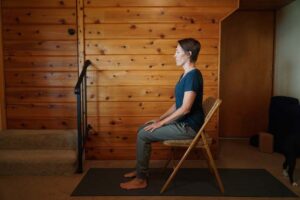
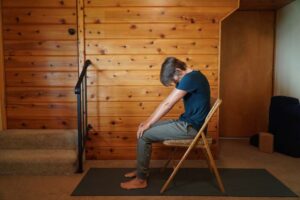
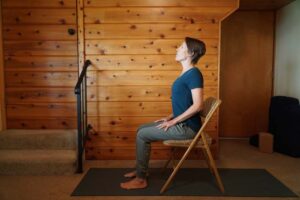
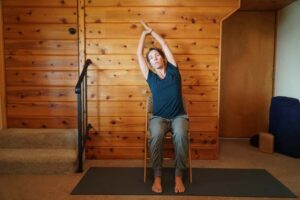
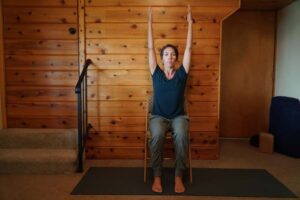
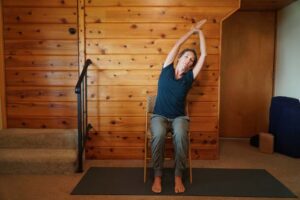
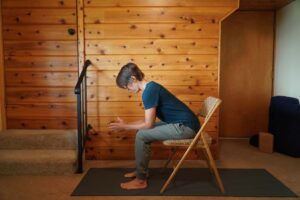
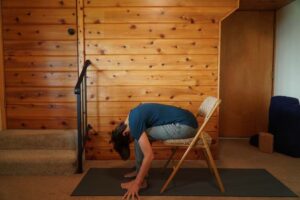
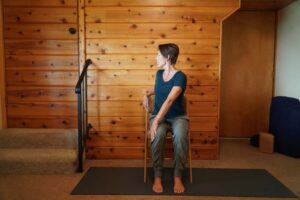
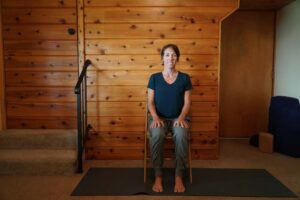
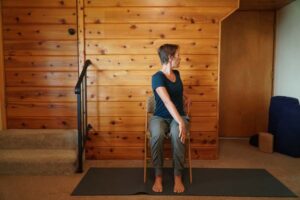
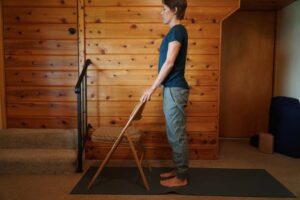
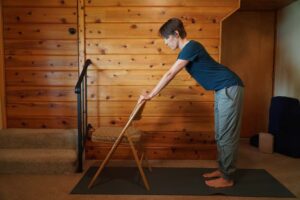
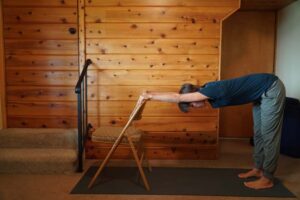



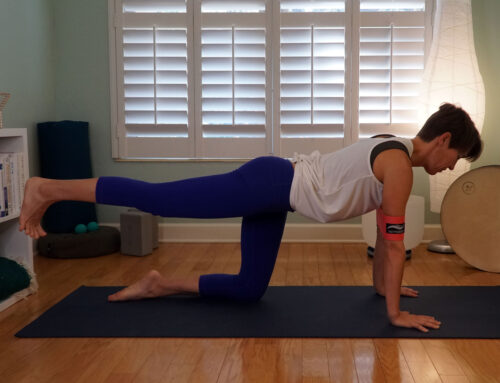

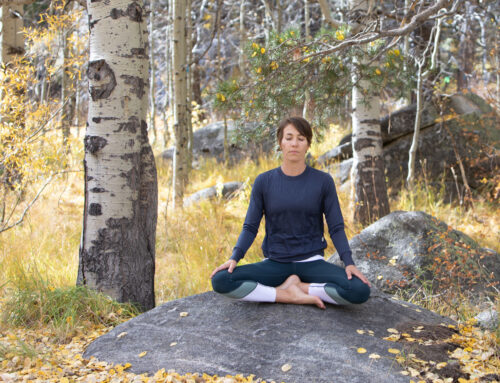

Leave A Comment